Municipal and state police are poorly trained and badly paid and half of the nation’s police officers suffer from work-related injuries or health conditions, according to data from the National Institute of Statistics and Geography (Inegi) and the nonprofit Causa en Común.
The lack of training and resources has come into the spotlight after the death of a Salvadoran migrant in Tulum, Quintana Roo, March 27. Two of the woman’s vertebrae were broken after a police officer held her down with a knee in the back.
A 2019 survey by Causa en Común showed that 19% of police had not received instruction on arrest and use of force and 29% had not received gender awareness training. Similarly, Inegi found in a 2017 national survey of police training standards that nearly 70% of police wanted to receive training on arrest tactics, detainee control and use of force.
Municipal police are the most lacking in pay and training. The 2017 survey found they have an average of 12 years of education. Nearly 25% have only elementary education, 63.5% have a high school diploma and 12.1% have attended college. The municipal force has a four to one ratio of men to women.
As for pay, a 2019 census found that just over 20% of municipal police officers earned 1,000 to 5,000 pesos a month (US $49 to $246) and 34.5% were paid 5,000 to 10,000 pesos ($246 to $492).
Nearly 20% of state and municipal officers have a chronic condition, with hypertension and diabetes being the most common, and 53% suffer from a work-related injury or health condition. The most common work-related health problems include weight gain or loss, anger, stress and cardiovascular conditions.
Source: Reforma (sp)
